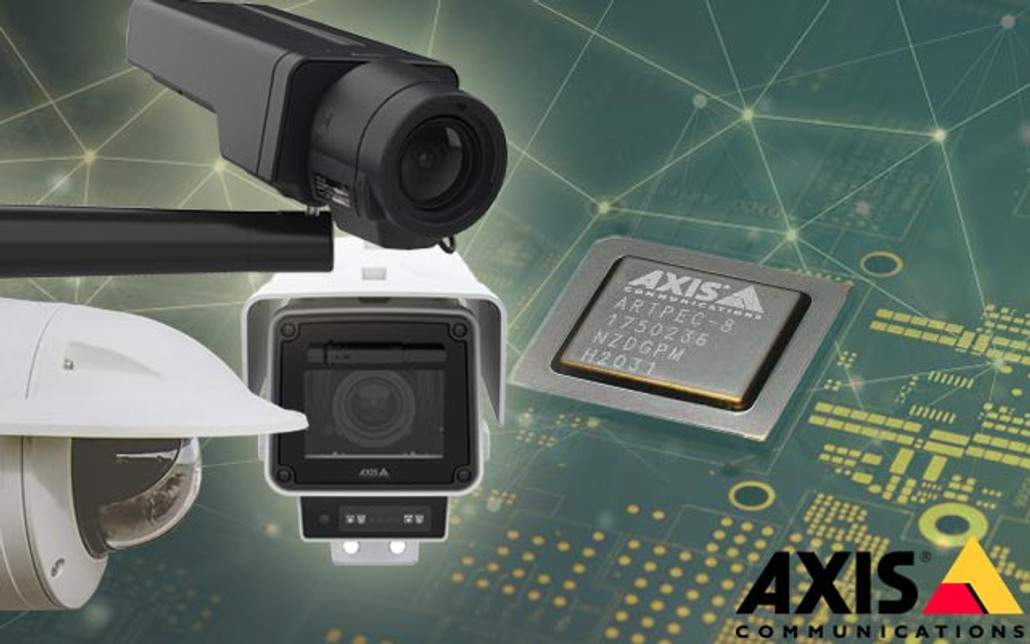Building on the power of its ARTPEC-7 predecessor; ARTPEC-8 is the latest System on Chip (SoC) from Axis Communications and promises to provide improved performance across the board – including next-level deep learning analytics on the edge. Improvements that were delivered by the previous chipset - such as tighter security features, advanced imaging and powerful compression are all enhanced in the new ARTPEC-8 chip.
The new chipset has been debuted within the new Axis Q1656/-LE range and is expected to be seen onboard the Q3536-LVE/38-LVE domes as well as most professional level Axis cameras going forward. Specifically designed by Axis to meet the processing power required for high-performance commercial surveillance, the chip also includes a built-in deep learning processing unit (DPLU) which allows highly granular object classification and improved accuracy in detection - directly on board the camera. In this blog we will be discussing the main benefits of the ARTPEC-8 chip – showcasing exactly what this powerful chip can do.
ARTPEC-8 is custom-built for optimum cybersecurity
Designed in-house by Axis, ARTPEC-8 benefits from being fully optimised for use in IP cameras. With over 25 years’ experience in network video, they are well positioned to know what an IP camera chipset requires for optimum performance – one of the key focuses being around cybersecurity. With full control over every aspect of the chip, Axis has been able to enhance security features including secure boot, signed firmware, their Edge Vault and Trusted Platform Module features, allowing them to “contribute to creating a smarter, safer world by addressing more and more important use cases.”
Analytics capabilities enhanced with deep learning
One of Axis’ most prominent developments over the years is the integration of video analytics on-board their cameras. ARTPEC-8 further accelerates the processing power seen in earlier chips and introduces more advanced deep learning procedures that allow the camera to recognise, build upon and adapt to learned processes - resulting in more nuanced and intuitive analytics. In practice, this allows processes such as object classification to perform more reliably and distinguish between, not only different types of objects, but sub-classifications of those object types – allowing more accurate real-time detection. The chipset’s deep learning capabilities are enhanced by Axis’ Scene Intelligence Technology, which uses algorithms to deliver valuable metadata - allowing the camera to adjust to changing circumstances, even under challenging viewing conditions. Furthermore, as data is analysed directly on the camera, response times are reduced - providing more accurate and timely events triggers and alerts that allow users to respond more quickly and more effectively.
High quality imaging and powerful compression
With continued support for advanced technologies such as Zipstream, Lightfinder 2.0 and Forensic WDR, ARTPEC-8 ensures optimal imaging in all conditions and improved compression with H.264 and H.265 encoding. With Lightfinder 2.0 and Forensic WDR, cameras can perform in both dark conditions and high contrast lighting, ensuring the best possible video capture in these conditions with no important details lost. Furthermore, Zipstream compression technology can further reduce costs associated with data storage without compromising video quality. With intelligent compression, Zipstream reduces bandwidth, resulting in fewer external servers and recorders being needed, saving money and providing a more scalable solution.
ARTPEC-8 in practice: Q1656 & Q1656-LE cameras
The first two cameras to feature this chipset are the Axis Q1656/LE cameras. Available in an indoor version ( Q1656) with a built-in microphone to record audio occurring in close proximity to the camera and an outdoor variant (Q1656-LE) featuring an integrated wiper to keep the lens cover clear and up to 50m of OptimisedIR illumination. These high-performance models take full advantage of this state-of-the-art chip to offer advanced solutions which are ideal for demanding applications that require intuitive monitoring, as well as the ability to utilise analytics for a deeper insight into the surveillance area – such as airport runways, ferry terminals and shopping centres. Both cameras also feature an i-CS varifocal lens that benefits greatly from the innovative imaging capabilities and enhanced processing power of ARTPEC-8 to provide a more intelligent installation process in which the camera can identify the lens mounted on it and adjust zoom and focus accordingly. Furthermore, these cameras benefit from highly detailed analytics capabilities and object detection on-board the camera, reducing the need for external analytics software, improving the detection process, and allowing users to respond more effectively to alerts.
More to come…
With the industry as a whole focusing towards the development of analytics performance and increased intelligence on-board the camera, it is great to see that the ARTPEC-8 chipset is aiming to tick some of these boxes. We are intrigued to see these improvements in action within the latest Axis Q16 models and then in the Axis Q35 models that are due for release later in Q1 2022. From then on it will be interesting to see where the inclusion of this chipset will be seen throughout the new Axis models of the future and what additional benefits emerge.



